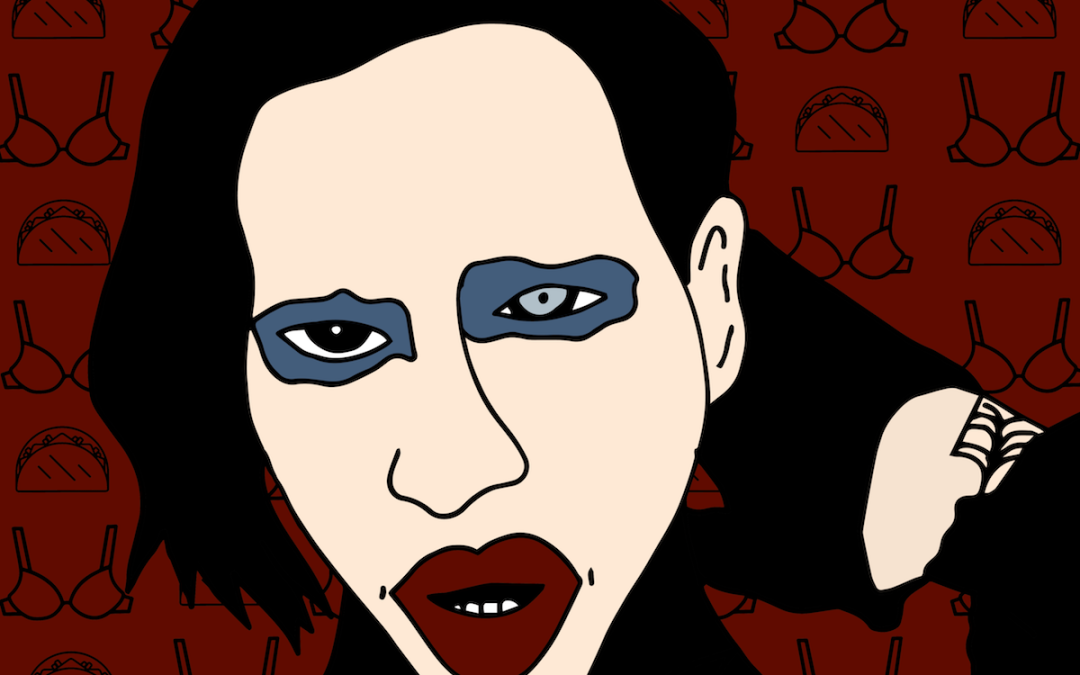
Illustration by Mary Anne Carter
Last Wednesday culminated in an Auburn Taco Bell parking lot with several friends wearing seven-layer burritos as bras. I alternately shotgunned Rainier and taco sauce packets, reeling from the delight of what for most of us had been our first Marilyn Manson concert. Shielding my nipples from the horrified passengers of an SUV covered in confederate flag and Trump stickers, I thought simply “What a lovely moment!” (okay, maybe just “WOOOO!”) My journey to that parking lot had lasted nearly two decades.
In middle school I wore a tattered, oversized T shirt with a wolf airbrushed on it every day and played Dungeons and Dragons. All my friends were boys, who I was mysteriously unafraid of—it would be a few years before I figured out why the girls terrified me. Having spent my childhood obsessed with Lord of the Rings and Narnia, the transition to adult social interaction was a confusing one. Adulthood seemed boring and stressful, and I didn’t see the point. There were some pretty serious moments of questioning the merits of existence.
Then in the hall one day a kid I assumed was a girl, wearing a giant foam cowboy hat and a Hawaiian shirt, blurted “Teacher says I’m a dip shit!” in wildly exaggerated fake western accent. I laughed in a way I had never laughed before.
I laughed at the Simpsons, but I actually had no idea a regular human—a peer, no less, could be funny that way. I used to anxiously anticipate the Simpsons for hours, because it was the only source of humor I knew. This magic kid was Tom, and we became best friends immediately. He was hilarious, and at the time, androgynous like me. I still credit him for my first lesson in how to be really funny. I abandoned make-believe for the craft of telling jokes. Through him I met Jesse and Lyle, who, like Tom, loved Nine Inch Nails and Marilyn Manson. Between the three of them they had every Manson album, which I eagerly borrowed.
I’d always loved music, but experienced a unique rapport the first time I heard Smells Like Children. Marilyn Manson was irreverent and dark, but too clever to be brainlessly shocking. His lyrics were well-crafted and frequently thought-provoking. I thought it was cool he had tits in some of his videos, apparently completely unafraid of being androgynous, which made me more comfortable with my ripped jeans and distinctly unfeminine mop of hair.
Shortly after buying Antichrist Superstar, I had my first orgasm, and understood why people don’t just kill themselves upon reaching adulthood. I also learned in a very rudimentary way something crucial and beautiful about the physics of music. Not only do the patterns of tension and release in well-crafted pop songs mimic the leaps and plateaus of the ascent to orgasm, the vibration of an instrument in tune does something very—I mean there’s a reason vibrators are called vibrators. Though I couldn’t have put words to it at the time, I sensed that in addition to the thematic rapport I had with this music there was a formal or structural rapport. Having maybe experienced one or the other but never both at once, or to that degree, I was changed in a way that only the first handful of musicians a person loves change them. I felt a tremendous sense of possibility and started sharpie-ing and spray painting my shirts with Manson lyrics and logos.
Tom, Lyle, Jesse and I were legitimately screaming, black light poster-owning fans, but because our entire friendship revolved around humor, both the band and the coven we started were jokes. This was especially true of the band, a psychedelic “act” called the Electric Cupcake which involved four kazoos and the “Accordion 2000,” a wooden box of broken children’s instruments and various talking dolls that was played by violently shaking the box, rhythmically if possible. I’m sure it looked as if we were mocking hippies since we didn’t bother to take off our NIN and Manson shirts or dog collars before donning psychedelic jungle-print smoking jackets, but it wasn’t satire. It was so unselfconscious it was probably the last make-believe game any of us played.
Of course we had to try casting spells when Lyle acquired a copy of the Necronomicon, which we learned of from Marilyn Manson’s autobiography. To do it properly, we decided a coven was necessary. The coven was at least half a joke until, after casting a weather spell, lightning flashed over our middle school play field. We had all seen The Craft–we never picked up the Necronomicon again.
I hope everyone has experienced what my friends and I felt when we heard Manson had an upcoming tour date in Seattle. As the moon pulls the tides, that music inspired in us a sense of limitless possibility, plus a parade of stupid/awesome/hilarious projects, and tickets to the moon were on sale. The concert was lunch conversation for weeks. Then, days before the show, I chickened out. I think the same possibility that compelled me was too scary for 13-year-old me close up—as if I might go somewhere from which I could never return.
I wonder if it would have comforted me then to know that everywhere is somewhere from which you never return. I pursued the possibilities represented by that music in real life, with varying degrees of success. Seeing Marilyn Manson live at 30 obviously wasn’t the same as it would have been when I was 13 (though his voice is still great) but at 13 I wasn’t capable of turning a desolate parking lot into a half-eaten burrito lingerie show.
[wc_spacing size=”40px”]
[wc_divider style=”solid” line=”single” margin_top=”” margin_bottom=””]


You must be logged in to post a comment.